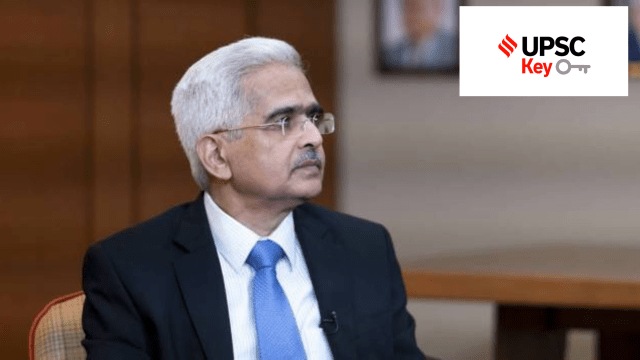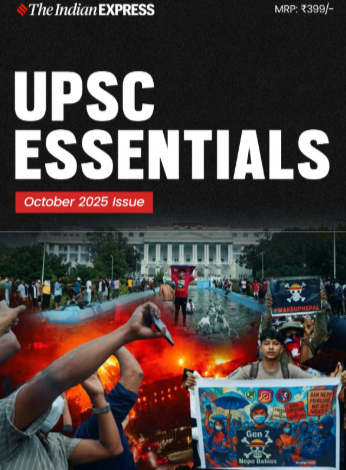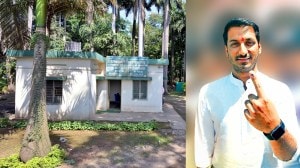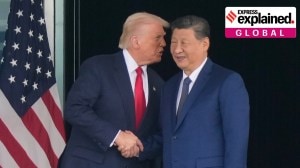Priya Kumari Shukla is a Senior Copy Editor in the Indian Express (digital). She contributes to the UPSC Section of Indian Express (digital) and started niche initiatives such as UPSC Key, UPSC Ethics Simplified, and The 360° UPSC Debate. The UPSC Key aims to assist students and aspirants in their preparation for the Civil Services and other competitive examinations. It provides valuable guidance on effective strategies for reading and comprehending newspaper content. The 360° UPSC Debate tackles a topic from all perspectives after sorting through various publications. The chosen framework for the discussion is structured in a manner that encompasses both the arguments in favour and against the topic, ensuring comprehensive coverage of many perspectives. Prior to her involvement with the Indian Express, she had affiliations with a non-governmental organisation (NGO) as well as several coaching and edutech enterprises. In her prior professional experience, she was responsible for creating and refining material in various domains, including article composition and voiceover video production. She has written in-house books on many subjects, including modern India, ancient Indian history, internal security, international relations, and the Indian economy. She has more than eight years of expertise in the field of content writing. Priya holds a Master's degree in Electronic Science from the University of Pune as well as an Executive Programme in Public Policy and Management (EPPPM) from the esteemed Indian Institute of Management Calcutta, widely recognised as one of the most prestigious business schools in India. She is also an alumni of Jamia Milia Islamia University Residential Coaching Academy (RCA). Priya has made diligent efforts to engage in research endeavours, acquiring the necessary skills to effectively examine and synthesise facts and empirical evidence prior to presenting their perspective. Priya demonstrates a strong passion for reading, particularly in the genres of classical Hindi, English, Maithili, and Marathi novels and novellas. Additionally, she possessed the distinction of being a cricket player at the national level. Qualification, Degrees / other achievements: Master's degree in Electronic Science from University of Pune and Executive Programme in Public Policy and Management (EPPPM) from Indian Institute of Management Calcutta ... Read More
UPSC Key- May 30, 2023: Know about Evergreening of Loans, Mo Ghara scheme, Insurgency and Ethanol Blending
Exclusive for Subscribers from Monday to Friday: The Indian Express UPSC Key May 30, 2023, will help you prepare for the Civil Services and other competitive examinations with cues on how to read and understand content from the most authoritative news source in India.
 UPSC Key May 2023: Here's what you should be reading from the May 30, 2023 edition of The Indian Express
UPSC Key May 2023: Here's what you should be reading from the May 30, 2023 edition of The Indian Express Important topics and their relevance in UPSC CSE exam for May 30, 2023. If you missed the May 29, 2023 UPSC key from the Indian Express, read it here
FRONT PAGE
Das cautions banks against hiding stress, governance issues
Syllabus:
Preliminary Examination: Economic and Social Development-Sustainable Development, Poverty, Inclusion, Demographics, Social Sector Initiatives, etc.
Main Examination: General Studies III: Indian Economy and issues relating to planning, mobilization, of resources, growth, development and employment.
Key Points to Ponder:
• What’s the ongoing story– Reserve Bank of India Governor Shaktikanta Das Monday raised concerns over banks adopting over-aggressive growth strategies and using innovative methods for evergreening of loans — reviving a loan on the verge of default by extending more loans to the same borrower. Das, who was addressing bank board, red-flagged corporate governance issues and said that during the supervisory process, certain instances of concealing the real status of stressed loans have come to the notice of the RBI.
• “Banks adopting over-aggressive growth strategies and using innovative methods for evergreening of loans”-What have you understood by this statement?
• What sort of over-aggressive growth strategies and innovative methods for evergreening of loans?
• What is meant by evergreening of loans?
• Corporate governance issues in Banks-can you highlight some of the issues?
• For Your Information-The process of evergreening of loans is typically a temporary fix for a bank. If an account turns NPA, banks are required to make higher provisions which will impact their profitability. To avoid classifying a loan as non-performing asset (NPAs), banks adopt evergreening. The RBI Governor’s caution on evergreening of loans comes when government has been counting on the resolution of the twin balance sheet problem of overleveraged companies and high bank NPAs to catalyse higher GDP growth.
• What is twin balance sheet crisis in India?
• “Stating that business models of banks should be robust and prudent, Das said bank boards need to pay specific attention to the asset liability management (ALM) in banks,”-Comment
• First of all, what is asset liability management (ALM) in banks?
• Why recently, RBI has started closely monitoring the business models of banks and financial institutions?
• How corporate governance in banks, can have the potential to cause some degree of volatility in the banking sector?
• Recent bank failures in the USA-know in detail
Other Important Articles Covering the same topic:
THE CITY
Can’t force citizen to choose between right to education and reproductive autonomy: HC
Syllabus:
Preliminary Examination: Indian Polity and Governance-Constitution, Political System, Panchayati Raj, Public Policy, Rights Issues, etc.
Main Examination: General Studies II: Issues relating to development and management of Social Sector/Services relating to Health, Education, Human Resources.
Key Points to Ponder:
• What’s the ongoing story-Granting relief to a university student who was denied maternity leave, the Delhi High Court has said that citizens could not be forced to choose between their right to education and their right to exercise reproductive autonomy.
• What is the issue exactly?
• What exactly High Court said?
• For Your Information-The HC was hearing the student’s plea seeking direction to the University Grants Commission (UGC) to frame specific rules and regulations for grant of maternity leave for post-graduate and undergraduate courses. The woman had enrolled in Chaudhary Charan Singh University in December, 2021 to pursue a two-year M Ed regular course. She filed an application for maternity leave before the Dean and Vice-Chancellor concerned of the university. On February 28, her request was denied. Thereafter, she approached the UGC. When she did not receive a response, she moved the HC.
• “The citizens could not be forced to choose between their right to education and their right to exercise reproductive autonomy”-Analyse
Other Important Articles Covering the same topic:
📍On reproductive rights, India’s MTP and Surrogacy Acts don’t go far enough
EXPRESS NETWORK
ISRO launches first of five second-gen navigation satellites
Syllabus:
Preliminary Examination: Current events of national and international importance.
Mains Examination: General Studies III: Science and Technology- developments and their applications and effects in everyday life.
Key Points to Ponder:
• What’s the ongoing story- The Indian Space Research Organisation (ISRO) launched the first of the second-generation satellites for its navigation constellation successfully on Monday morning. The 2,232 kg satellite, the heaviest in the constellation, was launched by a Geosynchronous Satellite Launch Vehicle (GSLV) rocket that lifted off from Sriharikota at 10:42 am. Each of the seven satellites currently in the Indian Regional Navigation Satellite System (IRNSS) constellation, operationally named NavIC, weighed much less — around 1,425 kg — at liftoff. They all rode the lighter Polar Satellite Launch Vehicle (PSLV), ISRO’s workhorse launch rocket.
• “I do believe that the naughty boy has been fully tamed,” Why this epithet given to the
Launch vehicle?
• What is NavIC (Navigation with Indian Constellation)?
• How does NavIC compare?
• Why is India promoting NavIC?
• What is the significance of NavIC?
• Applications of NavIC-Know in detail
• What are the issues and challenges associated with NavIC?
• What other navigation systems around the world are in use?
• What’s new in the second-generation NavIC satellite?
• What is the significance of the atomic clock on board the NVS-01 payload?
• What about the age of the satellites?
• What practical purpose does the NAvIC constellation serve for users?
• What is the advantage of having a regional navigation system?
• Do You Know-India is the only country that has a regional satellite-based navigation system. There are four global satellite-based navigation systems — the American GPS, the Russian GLONASS (GLObalnaya NAvigatsionnaya Sputnikovaya Sistema), the European Galileo, and the Chinese Beidou. Japan has a four-satellite system that can augment GPS signals over the country, similar to India’s GAGAN (GPS Aided GEO Augmented Navigation). Once fully operational — with ground stations outside India for better triangulation of signals — NavIC open signals will be accurate up to 5 metres and restricted signals will be even more accurate. GPS signals by contrast are accurate up to around 20 metres. Work is underway to set up ground stations in Japan, France, and Russia, ISRO officials said. NavIC provides coverage over the Indian landmass and up to a radius of 1,500 km around it. In this region, NavIC signals will likely be available in even hard-to-reach areas. Unlike GPS, NavIC uses satellites in high geo-stationery orbit — the satellites move at a constant speed relative to Earth, so they are always looking over the same region on Earth. NavIC signals come to India at a 90-degree angle, making it easier for them to reach devices located even in congested areas, dense forests, or mountains. GPS signals are received over India at an angle.
Other Important Articles Covering the same topic:
📍What is NavIC, India’s home-grown alternative to the GPS navigation system?
Odisha launches new credit-linked housing scheme for the rural poor
Syllabus:
Preliminary Examination: Economic and Social Development-Sustainable Development, Poverty, Inclusion, Demographics, Social Sector Initiatives, etc.
Main Examination: General Studies II: Welfare schemes for vulnerable sections of the population by the Centre and States and the performance of these schemes; mechanisms, laws, institutions and Bodies constituted for the protection and betterment of these vulnerable sections.
Key Points to Ponder:
• What’s the ongoing story- The Naveen Patnaik-led Odisha government Monday announced a new initiative, Mo Ghara (My Home) – a credit-linked housing scheme for rural poor in the state with an aim to convert all kutcha houses into pucca ones – a promise made by the ruling Biju Janata Dal (BJD) in its 2019 election manifesto. The announcement, following a meeting of the state cabinet, marked the completion of the fourth year of the fifth term of the BJD government. The scheme is set to benefit around four lakh families. The announcement of the scheme a year before the 2024 general elections assumes significance politically as the BJP-led NDA government at the Centre has already sanctioned around 9.5 lakh houses under Pradhan Mantri Awas Yojana-Gramin (PMAY-G).
• What is Mo Ghara scheme?
• Mo Ghara scheme-Know its features and components
• Who is eligible?
• Who is not eligible?
• For Your Information-Under the Mo Ghara scheme, a beneficiary can avail housing loan of up to Rs 3 lakh that can be repaid in 10 years in easy instalments excluding one year moratorium period. “The state government will release capital subsidy to the loan account of the beneficiaries on completion of the house,” said chief secretary P K Jena. There will be four slabs of loan amount. The rates of the subsidy will be Rs 30,000 for a Rs 1 lakh loan, Rs 45,000 for Rs 1.5 lakh loan, and Rs 60,000 for a loan amount of Rs 2 lakh and Rs 3 lakh. The subsidy will be Rs 10,000 more across slabs for those belonging to the SC/ST category and for the differently abled. A family staying in a kutcha house or one pucca room with a concrete roof is eligible to get the loan under the Mo Ghara scheme. Families that have not availed of any government housing assistance or have availed assistance of below Rs 70,000 in the past with a monthly income below Rs 25,000 will also be eligible under the scheme. Families having four-wheelers or any member in government service or irrigated land of five acres or more will not be eligible for the loan.
Other Important Articles Covering the same topic:
📍Nine years of Modi govt: Infrastructure to housing, Union ministers highlight key projects
THE WORLD
China announces plan to land astronauts on moon by end of 2030
Syllabus:
Preliminary Examination: Current events of national and international importance.
Main Examination: General Studies II: Effect of policies and politics of developed and developing countries on India’s interests
Key Points to Ponder:
• What’s the ongoing story- China on Monday announced plans to send a manned mission to the moon by 2030 for lunar scientific exploration, amid its deepening space race with the West. The announcement was made by Lin Xiqiang, Deputy Director of the China Manned Space Agency (CMSA), as China is preparing to send a third set of astronauts to its space station on Tuesday.
• What is China’s manned mission to the moon called?
• China is working on the ambitious Chang’e-6 and Chang’e-7 missions-What are these missions?
• How Chang’e-6 and Chang’e-7 missions are different from each other?
• What is the race for outer space?
• For Your Information-China’s manned lunar mission came as the US space agency NASA aims to send a second manned mission to the moon by 2025 to explore the south pole for frozen water. For its part, the Indian Space Research Organisation (ISRO) has announced plans to launch its ambitious Chandrayaan-3 mission aimed at demonstrating critical technologies to land the spacecraft on the south pole. Chandrayaan-3 mission carries scientific instruments to study the thermo-physical properties of the lunar regolith, lunar seismicity, lunar surface plasma environment and elemental composition in the vicinity of the landing site. China in the past successfully launched uncrewed missions to the moon which included a rover. China has also sent a rover to Mars.
• The Space Race between China and USA-is it correct to say?
Other Important Articles Covering the same topic:
📍China unveils plan to build satellite system for space exploration
EXPLAINED
Many groups, deep fault lines: History of insurgency in Manipur
Syllabus:
Preliminary Examination: Current events of national and international importance.
Mains Examination:
• General Studies III: Linkages between development and spread of extremism and Role of external state and non-state actors in creating challenges to internal security
• General Studies III: Role of external state and non-state actors in creating challenges to internal security.
Key Points to Ponder:
• What’s the ongoing story-Amid fresh violence in Manipur, Chief Minister N Biren Singh told the media that 40 insurgents had been killed by security forces. The Kuki National Organisation (KNO) has countered his claims.
• What do you understand by ‘Insurgency’?
• Why is it called ‘Insurgency’?
• How Insurgency is different from Guerrilla warfare?
• What is the difference between militant and insurgent? How militancy is different from insurgency?
• Know these terms-Terrorism, Insurgency, Belligerency and Civil war
• What are the roots of the Kuki insurgency?
• Manipur has been in the cross-currents of India’s oldest insurgent movements-why?
• History of conflict in Manipur-Know in detail
• The Indian government enacted the Armed Forces Special Powers Act in 1958 in reaction to the Naga separatist activity, initially implementing it across Nagaland and parts of Manipur-How these States responded?
• What do you understand by ‘disturbed area’?
• What is the Suspension of Operations pact?
• What are the terms of the SoO pact?
• The Kuki-Zomi insurgent groups-Know in detail
• “The insurgent groups are intricately woven into the daily life in Manipur”-Comment
• Map Work-Manipur and adjoining areas
• Why fresh round of violence?
• What is the present status?
• What exactly triggered the violence in the state?
• Who are Kuki and Meitei?
• Which are the major communities residing in Manipur?
• For Your Information-The Meiteis are the largest community in Manipur. There are 34 recognized tribes, which are broadly classified as ‘Any Kuki Tribes’ and ‘Any Naga Tribes’. The central valley in the state accounts for about 10% of the landmass of Manipur, and is home primarily to the Meitei and Meitei Pangals who constitute roughly 64.6% of the state’s population. The remaining 90% of the state’s geographical area comprises hills surrounding the valley, which are home to the recognized tribes, making up about 35.4% of the state’s population.
• For some time now, two parallel and provocative narratives in the portrayal of Manipur history were being pushed from certain quarters-What are those two parallel and provocative narratives?•
• What was the Manipur High Court directive?
Other Important Articles Covering the same topic:
📍Explained: How big is insurgency threat in Manipur?
US DEBT CEILING CRISIS: WHAT IS THE DEAL BIDEN, MCCARTHY HAVE STRUCK
Syllabus:
Preliminary Examination: Current events of national and international importance.
Mains Examination: General Studies II: Effect of policies and politics of developed and developing countries on India’s interests, Indian diaspora.
Key Points to Ponder:
• What’s the ongoing story-Days before the US government’s debt default deadline, President Joe Biden and Republican House Speaker Kevin McCarthy agreed on a deal that can potentially avert the crisis. The Democrats-led US government had in January hit its debt ceiling — the amount it is legally allowed to borrow for its expenses. With no new money coming in, Treasury Department Secretary Janet Yellen had warned that funds would run out by the first week of June, and the government would then fail to discharge its financial obligations, such as paying salaries and welfare cheques. Coming after weeks of tense talks, the deal is being seen as a breakthrough, although nothing is final yet. Both Biden and McCarthy have to convince the more hardline factions in their own parties before the deal can be approved by the House.
• What are the key takeaways from the deal?
• What is the debt ceiling?
• For Your Information-The debt ceiling, or debt limit, is the total amount the US government is allowed to borrow to finance its expenditure, such as paying salaries and welfare allowances.
Currently, this limit is at $31.4 trillion. The Republicans, who have a majority in the House, are refusing to raise it unless the Democrat-run government agrees to their demands, which include a significant cut in spending. The debt limit was introduced in 1917, when the US entered World War I. Constitutionally, Congress controls the government’s purse strings. The debt ceiling was introduced in order to make it easier for the executive to operate without having to turn to Congress every time it wanted to spend — it allowed the government to borrow as required as long as it kept under the debt limit approved by Congress. According to the Treasury Department website, since 1960, “Congress has acted 78 separate times to permanently raise, temporarily extend, or revise the definition of the debt limit — 49 times under Republican presidents and 29 times under Democratic presidents.” The most recent raising was in 2021.
• What happens if the govt defaults?
• What do the Republicans want?
• Does Biden have any other way?
• Has anything similar happened earlier?
• Is there an alternative?
Other Important Articles Covering the same topic:
📍Debt limit standoff brings tough talk, little action as Joe Biden, world leaders watch for progress
📍US Debt deadline: What happens if the debt ceiling doesn’t get raised?
ECONOMY
BPCL plans trials to see if diesel spiked with ethanol can be a commercially viable proposition
Syllabus:
Preliminary Examination: General issues on Environmental ecology, Bio-diversity and Climate Change – that do not require subject specialisation.
Mains Examination: General Studies III: Conservation, environmental pollution and degradation, environmental impact assessment.
Key Points to Ponder:
• What’s the ongoing story-Government-owned refiner and fuel retailer Bharat Petroleum Corporation (BPCL) plans to soon conduct trials of diesel spiked with ethanol by running vehicles on the blended fuel on a pilot basis, senior company officials said. BPCL is currently in talks with the Ministry of Petroleum and Natural Gas, Automotive Research Association of India (ARAI), and a few automobile manufacturers regarding the pilot, which could be finalised over the next few days.
• What is Ethanol?
• What is Ethanol Blending?
• What is the Significance of Ethanol Blending?
• National Policy on Biofuel 2018-Know the key Features
• What amendments have been made in National Policy on Biofuel 2018 so far?
• What is the current blending status?
• Do You Know-If the trials end up being successful and establish technical and commercial viability, they could pave the way for large-scale blending of ethanol in diesel in the years to come. Unlike petrol, blending ethanol in diesel was not seriously considered until recently due to differences in the chemistry of the biofuel and diesel. Like petrol, ethanol is a Class A product, while diesel is a Class B product. Mixing diesel with a Class A product like ethanol would cause knocking in the engine, and therefore is seen as an option. However, BPCL has developed a binder or additive, which facilitates homogeneous blending of ethanol with diesel.
Other Important Articles Covering the same topic:
📍Ethanol blend target reached; nation, environment gain: PM
For any queries and feedback, contact priya.shukla@indianexpress.com
The Indian Express UPSC Hub is now on Telegram. Click here to join our channel and stay updated with the latest Updates.
UPSC Magazine

Read UPSC Magazine



- 01
- 02
- 03
- 04
- 05





























